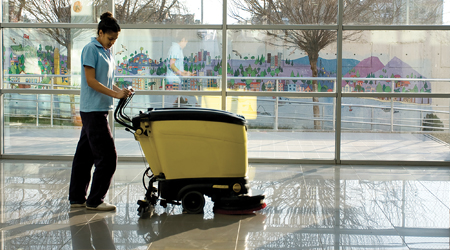
Facility cleaning managers are often faced with the added challenge of protecting their floors from the elements. Whether in the form of snow, torrential downpours or dry sand, different climates and seasons require custodians to adjust floor care procedures accordingly to prolong the life of floors and prevent slip and fall accidents.
Water, for example — one of the most damaging and hazardous effects of inclement weather — can wreak havoc on floors.
“In most regions from the northeast across the Midwest, you get into the moisture season,” says Stan Hulin, director of technology hard surfaces at milliCare Textile and Carpet Care in Spartanburg, South Carolina. “I call it the moisture season because it doesn’t matter if it comes in the form of mist, rain, sleet or snow, it all equals H2O. And when you have moisture combined with soil, you have a sticky substance that adheres to shoes and gets tracked into the facility.”
Mat Attack
When it comes to keeping floors free of soil and other outdoor contaminants, prevention is better than cure, say the experts. Therefore a facility cleaning manager’s first line of defense against adverse weather conditions is a good matting program.
“The best thing to have is walk-off [matting],” says Steve Spencer, facilities specialist, State Farm Insurance, Bloomington, Illinois. “That’s really key. The more soil you can trap at the door, the easier it is to get rid of. It extends the life of your floor finish, and it’s better from a safety standpoint.”
Over the last decade, State Farm has installed 30 to 40 feet of permanent walk-off tiles at the outside entrances of all its facilities nationwide. Additionally, the company has installed walk-off tiles in elevators, particularly in areas like Arizona where dry, sandy conditions prevail.
“If there’s a rainstorm, the sand will pack in the soles of people’s shoes, and when they stand in the elevator, some of that’s going to fall off,” explains Spencer. “So we try to do everything we can to prevent that soil from penetrating our building any further than the front door.”
Hulin recommends a three-stage walk-off matting system consisting of an outside scraper mat to remove large particulates, sand and gravel; an interior natural fiber mat, primarily to absorb moisture; and an interior textile mat, to remove any remaining moisture and soil from the shoe.
According to various industry studies, the more walk-off matting the better. For example, one study reveals that 25 feet of matting is needed to capture 100 percent of exterior soil. Another concludes that 39 feet removes 99 percent of particulate coming in from the outside.
In addition to matting, cleaning departments should focus on exterior surfaces beyond the scope of walk-off mats.
“Go outside and make sure your sidewalks are cleaned on a regular basis,” advises Hulin. “In the summer you might sweep, but in the winter you might hose them off and pressure wash them to keep sand or grit at a minimum.”
And don’t overlook the walk-off mats themselves, advises Spencer. Regular vacuuming of dry soil, or the use of a wet/dry vac in wintry conditions, can further boost efforts to prevent soil from entering the building.
Protecting Floors From Snow, Ice And Sand

 The Down and Dirty on Cleaning in Virus Season
The Down and Dirty on Cleaning in Virus Season How Surfactant Use is Expanding in Commercial Cleaning
How Surfactant Use is Expanding in Commercial Cleaning Operational Excellence Series 2025: Better Budgeting
Operational Excellence Series 2025: Better Budgeting
